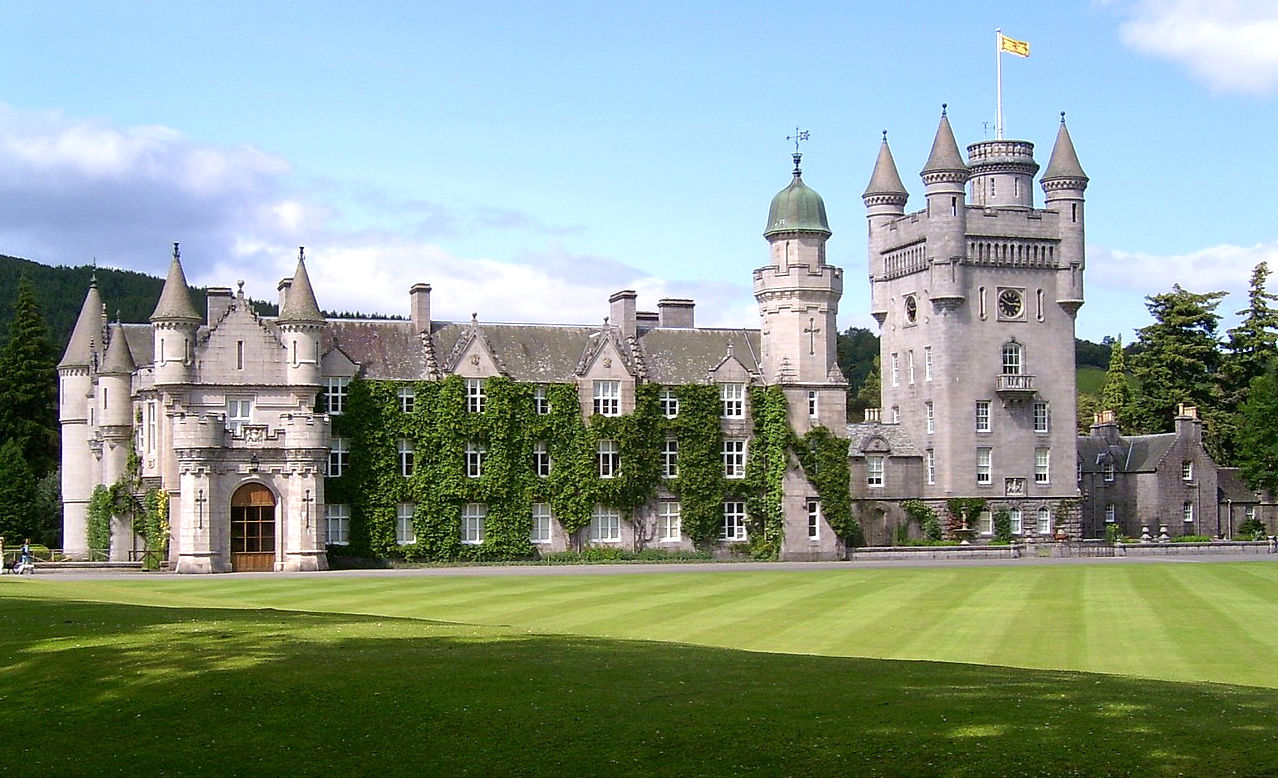
The
Royal Family's Scottish retreat, acquired by Prince Albert for himself
and Queen Victoria, is now
owned privately by Queen Elizabeth.
Balmoral Castle is a large estate house in Royal Deeside, Aberdeenshire, Scotland, owned by
Queen Elizabeth II. It is near the village of Crathie, 9 miles (14 kilometres) west of Ballater and 50 miles (80 kilometres) west of Aberdeen.
Balmoral has been one of the residences of the British royal family since 1852, when the estate and its original castle were bought from the Farquharson family by Prince Albert, the husband of Queen Victoria. Soon afterwards the house was found to be too small and the current Balmoral Castle was commissioned. The architect was William Smith of Aberdeen, and his designs were amended by Prince Albert. Balmoral remains
the private property of the Queen and is not part of the Crown Estate as
@ 2022, as is Sandringham
House. While Buckingham Palace
and Kensington
Palace belong to the Crown.
The castle is an example of Scottish baronial architecture, and is classified by Historic Environment Scotland as a category A listed building. The new castle was completed in 1856 and the old castle demolished shortly thereafter.
The Balmoral Estate has been added to by successive members of the royal family, and now covers an area of approximately 50,000 acres (20,000 hectares). It is a working estate, including grouse moors,
forestry and
farmland, as well as managed herds of deer, Highland cattle, and ponies.
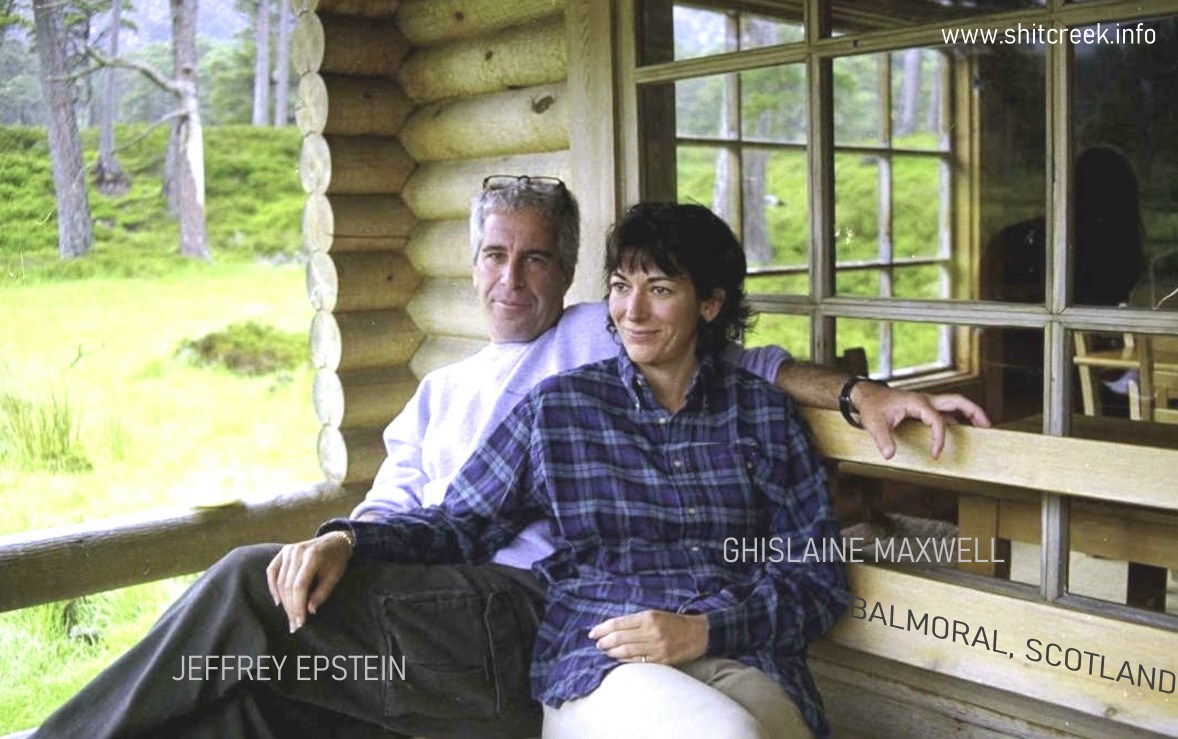
IMMORAL
GUESTS ON THE HUNT? - Jeffrey Epstein and
Ghislaine Maxwell seen here at
Balmoral,
the Scottish retreat of the Royals, as guests of Prince Andrew. The
Duke of York stands accused
of sexual assault by Virginia Roberts Giuffre (technically rape) of
a minor in the US, with Ms Maxwell convicted of sex trafficking in
December 2021. Epstein died in prison, thought to have been a suicide,
having been convicted of umpteen sex offences with girls under the age
of consent, making him a very predatory pedophile.
Questions as to any involvement of other Royals, or grooming efforts in
Scotland, remain un-investigated as of January 2022. The picture above
has raised many an eyebrow to (potentially) call the Monarchy into
disrepute, we imagine without justification - save that if what is said
about Ms Maxwell is true, it is unlikely
the pair will not have carried on their immoral grooming of young girls on their travels.
We
understand that Sandringham
is mentioned in their little black book as well, along with other
prominent names, including Tony
Blair, prime minister during one of the
darkest moments in modern history, the invasion of Iraq based on faulty
intelligence. How is that for immoral? With the State honouring the
butcher for such misdeeds. That seems to us to be a corruption of
justice. How can someone who authorizes the invasion of country to
depose another head of state, claiming a nuclear bomb factory existed,
be given an award for such blatant human rights abuses - unless he is
being rewarded for keeping mum about an alternative agenda for example.
That is our opinion, protected by Articles 9 and 10 of the Human
Rights Act 1998. There was no trace of nuclear weapons found. The
killed hundreds of human beings for nothing. Other than showing how
brutal a civilised country can be in intolerance of other cultures. It
could be regarded as an act of Genocide.
Potentially a matter for the International
Criminal Court.
Though called a castle, Balmoral's primary function is that of a country house. It is a "typical and rather ordinary" country house from the Victorian period. The tower and "pepper pot turrets" are characteristic features of the residence's Scottish baronial style. The seven-storey tower is an architectural feature borrowed from medieval defensive tower houses. The "pepper pot" turrets were influenced by the style of 16th-century French châteaux. Other features of the Scottish baronial style are the crow-stepped gables, dormer windows, and battlemented porte-cochère.
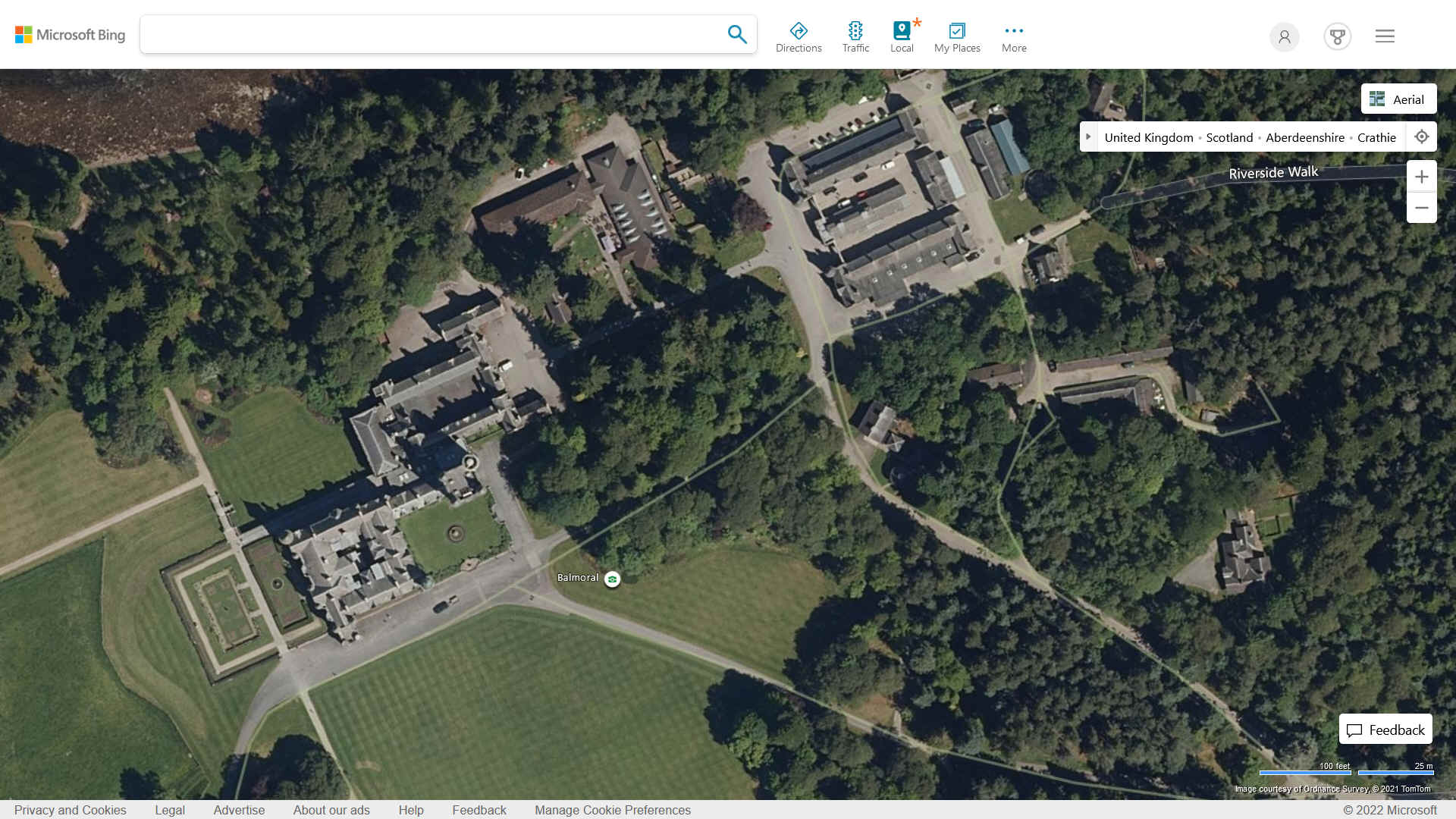
Satellite
picture of Balmoral and surrounding estate (working) buildings, seen as it was in
2021.
Balmoral Estate is within the Cairngorms National Park and is partly within the Deeside and Lochnagar National Scenic Area. The 50,000-acre (20,000-hectare) estate contains a wide variety of landscapes, from the Dee river valley to open mountains. There are seven Munros (hills in Scotland over 3,000 ft or 914.4 m) within the estate, the highest being Lochnagar at 3,789 ft (1,155 m). This mountain was the setting for a children's story, The Old Man of Lochnagar, told originally by
Prince Charles to his younger brothers, Andrew and Edward. The story was published in 1980, with royalties accruing to The Prince's Trust. The estate also incorporates the 7,500-acre (3,000-hectare) Delnadamph Lodge estate, bought by Elizabeth II in 1978.
The estate extends to Loch Muick in the southeast where an old boat house and the Royal Bothy (hunting lodge) now named Glas-allt-Shiel, built by Victoria, are located.
The working estate includes grouse moors, forestry, and farmland, as well as managed herds of deer, Highland
cattle, and
ponies. It also offers access to the public for
fishing (paid) and hiking during certain seasons.
Approximately 8,000 acres (3,200 hectares) of the estate are covered by trees, with almost 3,000 acres (1,200 hectares) used for
forestry that yields nearly 10,000 tonnes of
wood per year. Ballochbuie Forest, one of the largest remaining areas of old Caledonian pine growth in Scotland, consists of approximately 3,000 acres (1,200 hectares). It is managed with only minimal or no intervention. The principal mammal on the estate is the red
deer with a population of 2,000 to 2,500 head.
The areas of Lochnagar and Ballochbuie were designated in 1998 by the Secretary of State for Scotland as Special Protection Areas (SPA) under the European Union (EU) Birds Directive. Bird species inhabiting the moorlands include red grouse, black grouse, ptarmigan, and the capercaillie. Ballochbuie is also protected as a Special Area of Conservation by the EU Habitats Directive, as "one of the largest remaining continuous areas of native Caledonian Forest". In addition, there are four sites of special scientific interest on the
estate (SSSI).
The royal family employs approximately 50 full-time and 50–100 part-time staff to maintain the working estate.
There are approximately 150 buildings on the estate, including Birkhall, formerly home to Queen Elizabeth The Queen Mother, and used now by
Prince Charles and the
Duchess of Cornwall for their summer holidays. Craigowan Lodge is regularly used by the family and friends of the royal family and has also been used while Balmoral Castle was being prepared for a royal visit. Six smaller buildings on the estate are let as holiday cottages.
PURCHASE
BY PRINCE ALBERT 1852 & MODIFICATIONS
Queen Victoria and Prince Albert first visited Scotland in 1842, five years after her accession to the throne and two years after their marriage. During this first visit they stayed at Edinburgh, and at Taymouth Castle in Perthshire, the home of the Marquess of Breadalbane. They returned in 1844 to stay at Blair Castle and, in 1847, when they rented Ardverikie by Loch Laggan. Frequent rain during the latter trip led Sir James Clark, the queen's doctor, to recommend Deeside instead, for its healthier climate.
Sir Robert Gordon died in 1847 and his lease on Balmoral reverted to Lord Aberdeen. In February 1848 an arrangement was
made - that Prince Albert would acquire the remaining part of the lease on Balmoral, together with its furniture and
staff - without having seen the property first.
The royal couple arrived for their first visit on 8 September 1848. Victoria found the house "small but pretty", and recorded in her diary that: "All seemed to breathe freedom and peace, and to make one forget the world and its sad turmoils". The surrounding hilly landscape reminded them of Thuringia, Albert's homeland in Germany.
George Washington Wilson (1823–1893), Balmoral Castle, Scotland, 1860s, albumen print carte de visite, Department of Image Collections, National Gallery of Art Library, Washington, DC
Quickly, the house was confirmed to be too small and, in 1848, John and William Smith were commissioned to design new offices, cottages, and other ancillary buildings. Improvements to the woodlands, gardens, and estate buildings were also being made, with the assistance of the landscape gardener, James Beattie, and possibly by the painter, James Giles.
Major additions to the old house were considered in 1849, but by then negotiations were under way to purchase the estate from the trustees of the deceased Earl Fife. After seeing a corrugated iron cottage at the Great Exhibition of 1851, Prince Albert ordered a prefabricated iron building for Balmoral from E. T. Bellhouse & Co., to serve as a temporary ballroom and dining room. It was in use by 1 October 1851, and would serve as a ballroom until 1856.
The sale was completed in June 1852, the price being £32,000, and Prince Albert formally took possession that autumn. The neighbouring estate of Birkhall was bought at the same time, and the lease on Abergeldie Castle secured as well. To mark the occasion, the Purchase Cairn was erected in the hills overlooking the castle, the first of many.
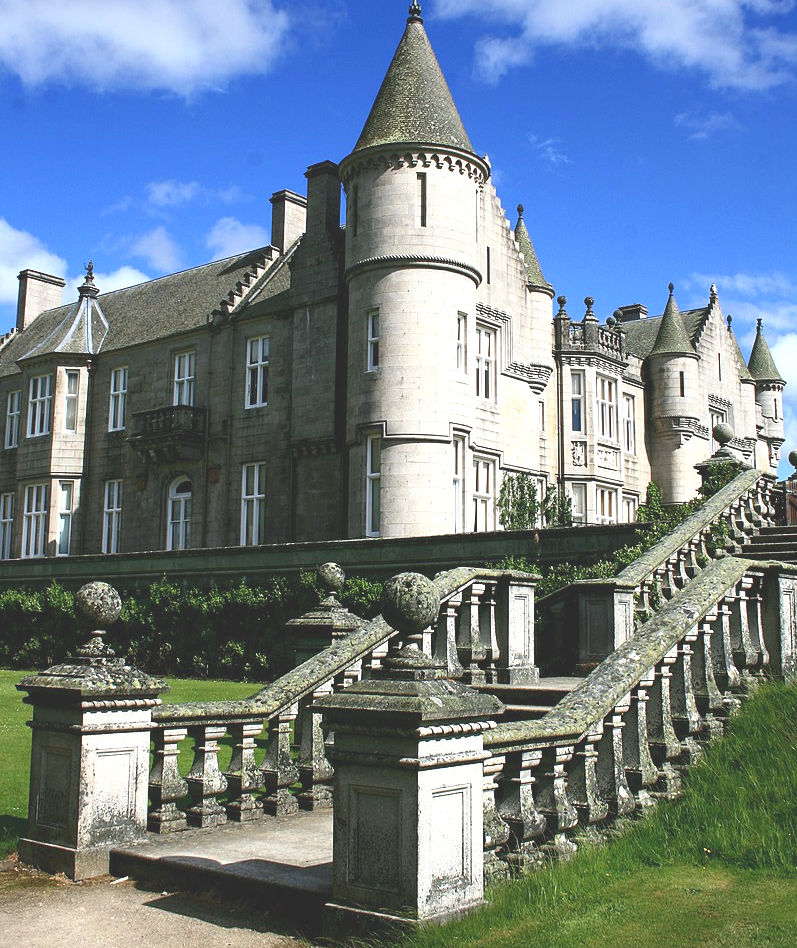
It's
a mix of styles, crafted in such a way, though not unique, as to be
pleasing overall. Built in a timescale so that Albert and Victoria could
enjoy it.
NEW HOUSE CONSTRUCTION
The growing family of Victoria and Albert, the need for additional staff, and the quarters required for visiting friends and official visitors such as cabinet members, however, meant that extension of the existing structure would not be sufficient and that a larger house needed to be built. In early 1852, this was commissioned from William Smith. The son of John Smith (who designed the 1830 alterations of the original castle), William Smith was the city architect of Aberdeen from 1852. On learning of the commission, William Burn sought an interview with the prince, apparently to complain that Smith previously had plagiarised his work, however, Burn was unsuccessful in depriving Smith of the appointment. William Smith's designs were amended by Prince Albert, who took a close interest in details such as turrets and windows.
There
is virtually no copyright in the design of a building, where almost
everything has been done before, and you only need to alter some measure
or detail to create something different. The exception would be a
building that was a registered design, with details of copyright-able
features. Or maybe a building with a unique feature like a tilting
roof for harvesting the sun's energy.
Construction began during summer 1853, on a site some 100 yards (90 metres) northwest of the original building that was considered to have a better vista. Another consideration was that whilst construction was ongoing, the family would still be able to use the old house.
Queen Victoria laid the foundation stone on 28 September 1853, during her annual autumn visit. By the autumn of 1855, the royal apartments were ready for occupancy, although the tower was still under construction and the servants had to be lodged in the old house. By coincidence, shortly after their arrival at the estate that autumn, news circulated about the fall of Sevastopol, ending the Crimean War, resulting in wild celebrations by royalty and locals alike. While visiting the estate shortly thereafter, Prince Frederick of Prussia asked for the hand of Princess Victoria.
The new house was completed in 1856, and the old castle subsequently was demolished. By autumn 1857, a new bridge across the Dee, designed by
Isambard Kingdom Brunel linking Crathie and Balmoral was finished.
Balmoral Castle is built from granite quarried at Invergelder on the estate. It consists of two main blocks, each arranged around a courtyard. The southwestern block contains the main rooms, while the northeastern contains the service wings. At the southeast is an 80-foot-tall (24-metre) clock tower topped with turrets, one of which has a balustrade similar to a feature at Castle Fraser. Being similar in style to the demolished castle of the 1830s, the architecture of the new house is considered to be somewhat dated for its time when contrasted with the richer forms of Scots baronial being developed by William Burn and others during the 1850s. As an exercise in Scots baronial, it is sometimes described as being too ordered, pedantic, and even Germanic as a consequence of Prince Albert's influence on the design.
However, the purchase of a Scottish estate by Victoria and Albert and their adoption of a Scottish architectural style was influential for the ongoing revival of Highland culture. They decorated Balmoral with tartans and attended highland games at Braemar. Queen Victoria expressed an affinity for Scotland, even professing herself to be a Jacobite. Added to the work of Sir Walter Scott, this became a major factor in promoting the adoption of Highland culture by Lowland Scots. Historian Michael Lynch comments that "the Scottishness of Balmoral helped to give the monarchy a truly British dimension for the first time".
Even before the completion of the new house, the pattern of the life of the royal couple in the Highlands was soon established. Victoria took long walks of up to four hours daily and Albert spent many days hunting deer and game. In 1849, diarist Charles Greville described their life at Balmoral as resembling that of gentry rather than royalty. Victoria began a policy of commissioning artists to record Balmoral, its surroundings, and its staff. Over the years, numerous painters were employed at Balmoral, including Edwin and Charles Landseer, Carl Haag, William Wyld, and William Henry Fisk. The royal couple took great interest in their staff. They established a lending library.
During the 1850s, new plantations were established near the house and exotic conifers were planted on the grounds. Prince Albert had an active role in these improvements, overseeing the design of parterres, the diversion of the main road north of the river via a new bridge, and plans for farm buildings. These buildings included a model dairy that he developed during 1861, the year of his death. The dairy was completed by Victoria. Subsequently, she also built several monuments to her husband on the estate. These include a pyramid-shaped cairn built a year after Albert's death, on top of Craig Lurachain. A large statue of Albert with a dog and a gun by William Theed, was inaugurated on 15 October 1867, the twenty-eighth anniversary of their engagement.
Following Albert's death, Victoria spent increasing periods at Balmoral, staying for as long as four months a year during early summer and autumn. Few further changes were made to the grounds, with the exception of some alterations to mountain paths, the erection of various cairns and monuments, and the addition of some cottages (Karim Cottage and Baile na Coille) built for senior staff. It was during this period that Victoria began to depend on her servant, John Brown. He was a local ghillie from Crathie, who became one of her closest companions during her long mourning.
In 1887, Balmoral Castle was the birthplace of Victoria Eugenie, a granddaughter of Queen Victoria. She was born to Princess Beatrice, the fifth daughter of Victoria and Albert. Victoria Eugenie would become the queen of Spain.
In September 1896, Victoria welcomed Emperor Nicholas II of Russia and Empress Alexandra, a granddaughter of Victoria, to Balmoral. Four years later Victoria made her last visit to the estate, three months before her death on 22 January 1901.
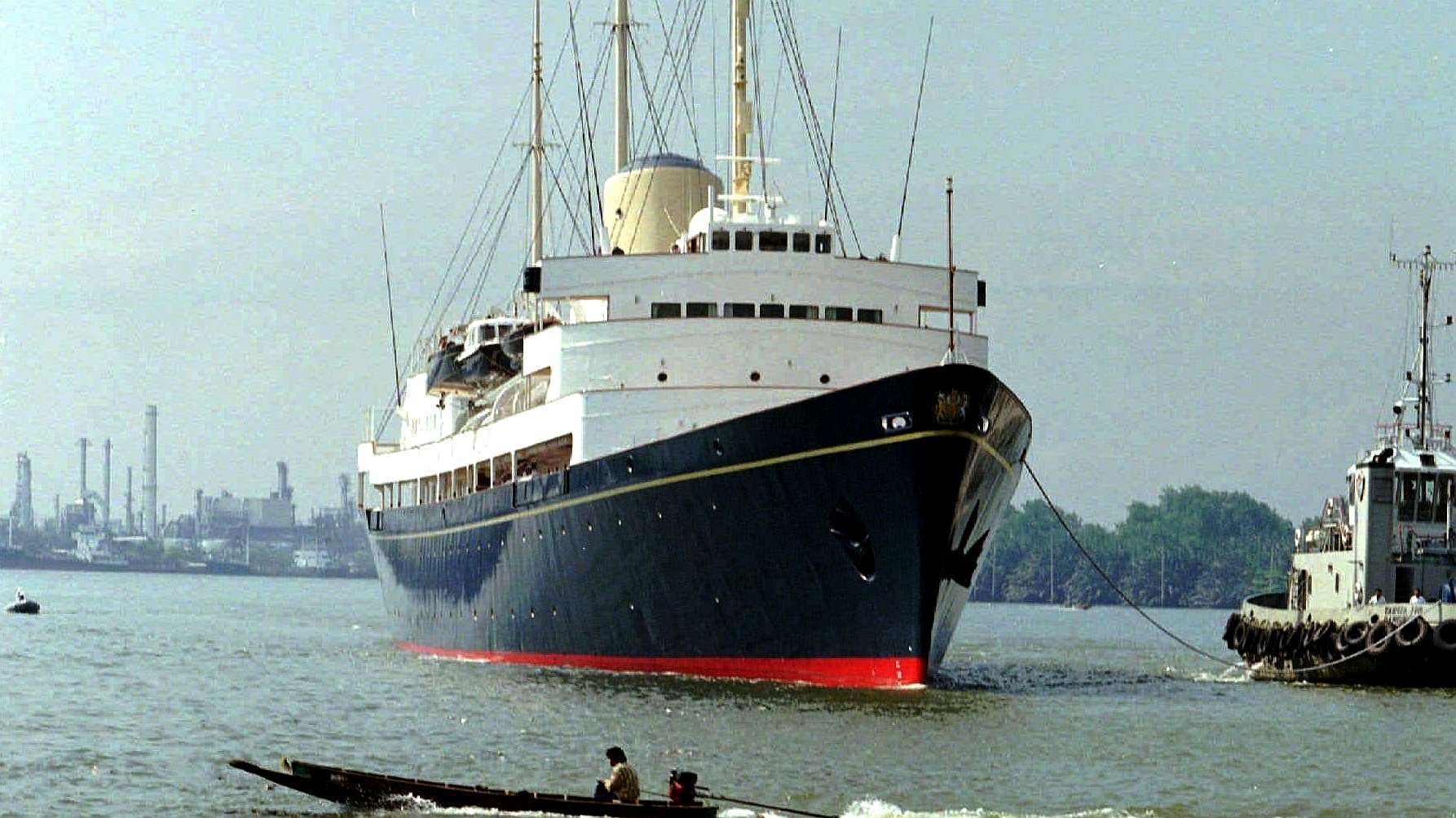
THE
ROYALS AFLOAT - A floating [gin] palace. 83rd in a long line of royal yachts that stretches back to 1660 and the reign of Charles II, BRITANNIA holds a proud place in British maritime history. Plans to build a new royal yacht to replace the VICTORIA AND ALBERT III began during the reign of King George VI. But The King died in 1952, four months before the keel of the yacht was laid. His daughter,
Princess
Elizabeth, succeeded him to the throne and the new Queen, together with her husband,
Prince
Philip, took a guiding hand in the design of the yacht, personally approving plans prepared by Sir Hugh
Casson, Consultant Architect and selecting furniture, fabrics and paintings.
On 11 December 1997, BRITANNIA was decommissioned at Portsmouth Naval Base in the presence of The Queen, The Duke of Edinburgh and fourteen senior members of The Royal Family.
Following BRITANNIA's decommissioning, proposals were put forward by cities around the UK, all competing to secure the ship. In April 1998, the Government announced that Edinburgh had been successful in its bid to bring BRITANNIA to the historic port of
Leith.
If
there is ever another Royal Yacht of such spledour, one hopes it might be solar
assisted and hydrogen powered, by way of an eco ship, to reduce the
carbon footprint of the super rich.
LINKS
& REFERENCE
https://en.wikipedia.org/wiki/Balmoral_Castle
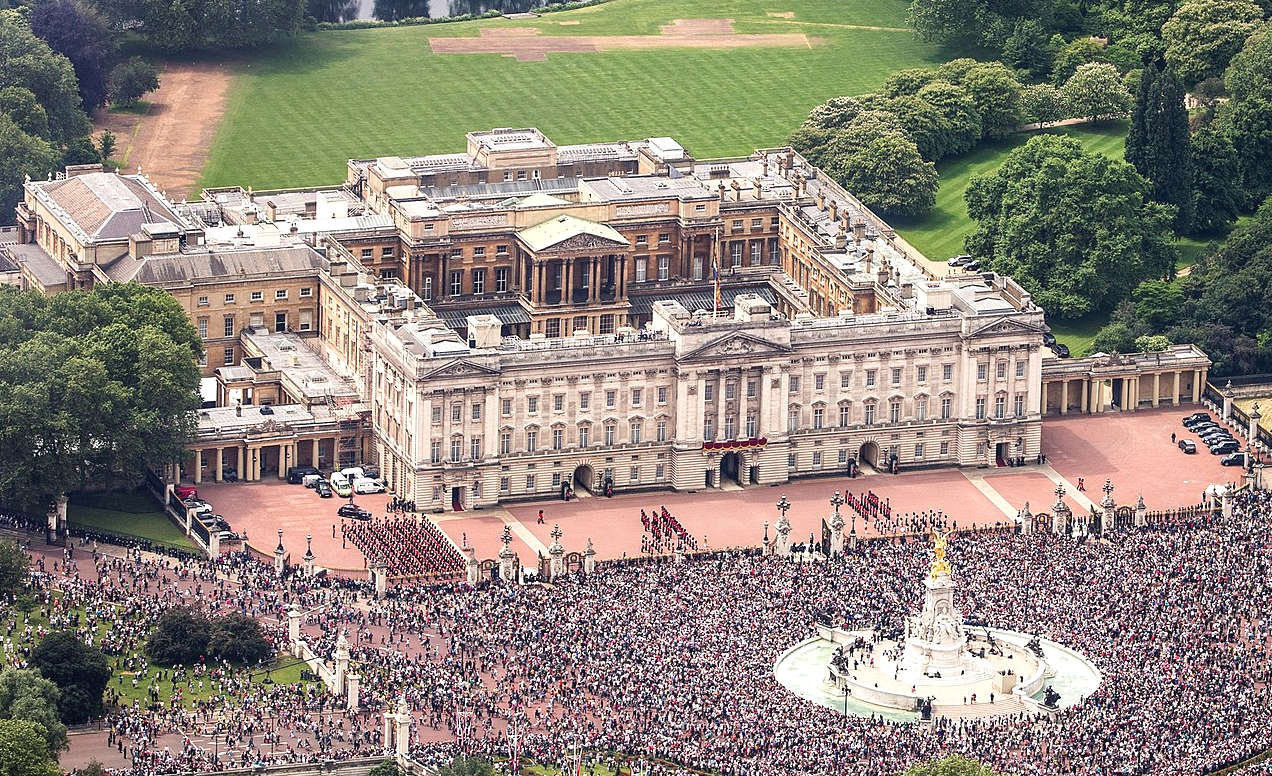
The
Royal Family's London HQ, where most national ceremonies and events take
place.





